
Hong Kong has a highly developed and sophisticated transport network, encompassing both public and private transport. Based on Hong Kong Government's Travel Characteristics Survey, over 90% of daily journeys are on public transport, the highest rate in the world. However, in 2014 the Transport Advisory Committee, which advises the Government on transportation issues, issued a report on the much-worsened congestion problem in Hong Kong and pointed at the excessive growth of private cars during the past 10–15 years.
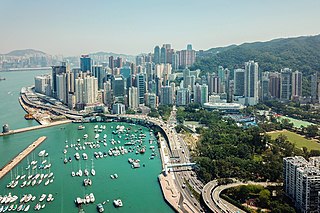
Causeway Bay is an area and a bay on Hong Kong Island, Hong Kong, straddling the border of the Eastern and the Wan Chai districts. It is a major shopping, leisure and cultural centre in Hong Kong, with a number of major shopping centres. The rents in the shopping areas of Causeway Bay were ranked as the world's most expensive for the second year in a row in 2013, after overtaking New York City's Fifth Avenue in 2012. When referring to the area, the Cantonese name is never written in English as "Tung Lo Wan".

Hong Kong Tramways (HKT) is a 3 ft 6 in narrow-gauge tram system in Hong Kong. Owned and operated by RATP Dev Transdev Asia, the tramway runs on Hong Kong Island between Kennedy Town and Shau Kei Wan, with a branch circulating through Happy Valley.

The Island line is one of ten lines of the MTR, the mass transit system in Hong Kong. It runs from Kennedy Town in the Western district to Chai Wan in the Eastern District on Hong Kong Island, passing through the territory's major business districts of Central, Wan Chai and Causeway Bay, and connecting them with built-up areas on the north shore of the island.
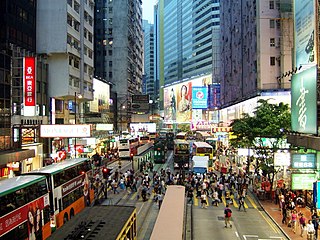
East Point was a spit on the northern shore of Hong Kong Island, Hong Kong. It extended from East Point Hill, i.e. Lee Garden towards Kellett Island and marked the eastern limits of the early City of Victoria. The piece of land separated Causeway Bay in the east and Wong Nai Chung in the west. Streams and muds from Tai Hang and Wong Nai Chung shaped the spit.

Central is an MTR station located in the Central area of Hong Kong Island. The station's livery is firebrick red but brown on the Tsuen Wan line platforms. The station is the southern terminus of the Tsuen Wan line, a stop on the Island line, and connects to Hong Kong station, which serves the Tung Chung line and the Airport Express.

Causeway Bay is a station on the MTR network on Hong Kong Island, Hong Kong. The station is between Wan Chai and Tin Hau stations on the Island line. It serves the locality of East Point within Wan Chai District.
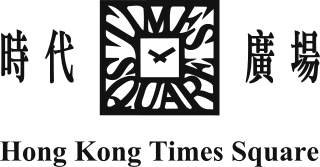
Times Square is a luxury shopping centre and office tower complex in Causeway Bay, Hong Kong. The complex, owned by Wharf Properties, part of The Wharf (Holdings) Limited group, opened on 13 April 1994.
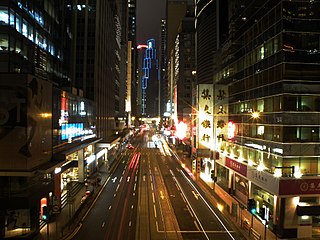
Des Voeux Road Central and Des Voeux Road West are two roads on the north shore of Hong Kong Island, Hong Kong. They were named after the 10th Governor of Hong Kong, Sir William Des Vœux. The name was sometimes spelt with the ligature œ in pre-war documents but is nowadays spelt officially as Des Voeux Road.

King's Road is a major east–west road along the north of Hong Kong Island, Hong Kong, stretching from Causeway Bay, where it joins Causeway Road, to Sai Wan Ho, where it joins Shau Kei Wan Road.

Yee Wo Street is a street in East Point and Causeway Bay, Hong Kong Island, Hong Kong. Its junction with Hennessy Road is one of the busiest junctions in Hong Kong.

Causeway Road is a main road in Hong Kong. Situated in Causeway Bay, it joins Yee Wo Street in the west and King's Road. It is a boundary of Eastern District and Wan Chai District. North side of the road is Victoria Park in Eastern District while in the Wan Chai District in the south are Queen's College and Hong Kong Central Library.

Percival Street is a street in the East Point and Happy Valley, Hong Kong Island, Hong Kong. The street spans from Gloucester Road in the north to Leighton Road in the south. Between Hennessy Road and Leighton Road, the street is with a branch of Hong Kong Tramways leading to Happy Valley. It is estimated that on average the annual rent per square feet for retailing here is US$2300 annually on average, second to US$2500 in Fifth Avenue, United States. It is also one of the major streets occupied during Occupy movement in 2014.

Leighton Road is a main road in Causeway Bay, Hong Kong. It begins east of Causeway Road and ends at the west of the junction with Morrison Hill Road and Canal Road.
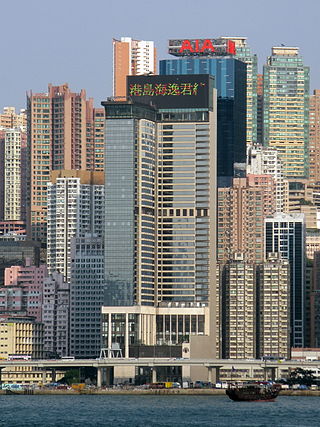
Fortress Hillor Pau Toi Shan is a hill and a colloquial name used to describe the fringe area between the areas of North Point and Causeway Bay on the north shore of Hong Kong Island, Hong Kong. As it is not an actual legally defined neighbourhood, its extent varies greatly between individuals. Fortress Hill generally includes the western part of North Point lying west of Oil Street, and the eastern part of Causeway Bay. There are a number of private residential estates, office buildings, hotels and serviced apartments in this area.
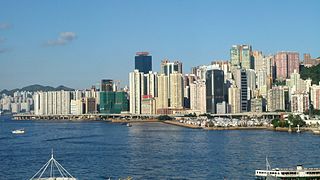
Tin Hau is an area in Wan Chai District, on the north side of Hong Kong Island, in Hong Kong.

Trams in Hong Kong include the Hong Kong Tramways, the Peak Tram and the Light Rail Transit.

Paterson Street is a street in Causeway Bay, Hong Kong Island, Hong Kong. It starts north at Victoria Park Road, crosses Kingston Street and Great George Street and ends at Yee Wo Street or Canadian Street to the south.

Shek Tong Tsui Terminus is a tram stop and one of the seven termini of Hong Kong Tramways, a double-decker tram system. Located in Shek Tong Tsui, it is one of the system's three termini in the Central and Western District on Hong Kong Island.

























